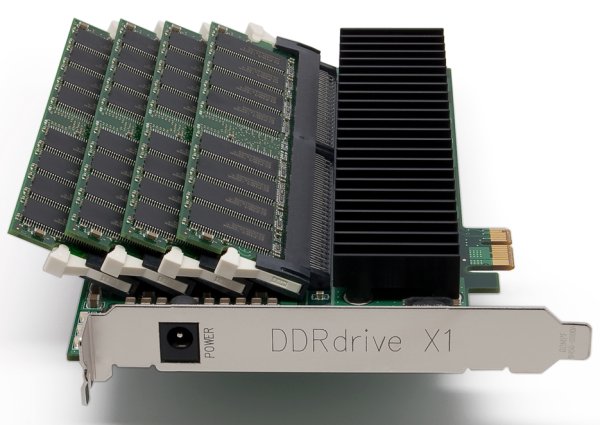The DDRdrive X1 contains 4GB DRAM and 4GB of SLC NAND to deliver a massive 300,000+ random 512B read IOPS and 200,000+ random 512B write IOPS, significantly more than all other SSDs currently available on the market. The Fusion-io ioDrive Duo SSD for instance offers 186,000 read IOPS and 167,000 write IOPS.
The DDRdrive x1 device offers sustained sequential read speed of up to 215MB/s and write speeds of up to 155MB/s. The minimum idle power draw is 4.96W and the maximum active power draw is just 9.91W. The DDRdrive x1 is priced at $1,495 and comes with a 5-year limited warranty. More details can be found at the company's website.
Each DDRdrive X1 presents a 4GB storage capacity, physically composed of 4GB DRAM and 4GB of NAND. Both solid-state technologies work in concert to provide the superior characteristics of DRAM (speed, reliability, and longevity) with the non-volatility of NAND. All IO operations are directed to DRAM for unsurpassed IOPS performance with NAND performing an entire drive backup or restore in less than 60 seconds.
At the core of the DDRdrive X1 Storage System is the custom high performance IOPS Engine. An FPGA based solid-state storage accelerator, in-the-field upgradable and purpose-built to dominate IO operations. The IOPS Engine is controlled by a highly tuned device driver, together providing unprecedented end-to-end IOPS optimization.
The DDRdrive X1 offers an extremely potent and cost effective solution when combined with a “Surgical Strike” methodology, i.e. relocate only the IOPS intensive data on card, while leaving the remaining storage system intact. Databases (tables, indices, transaction logs) are a prime target. Using Microsoft Windows built-in RAID support, DDRdrive X1’s can be spanned (capacity), striped (performance), mirrored (redundancy), and RAID-5 configured.
“For targeted IOPS intensive applications, the DDRdrive X1 is the highest performance, most power
